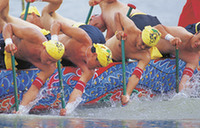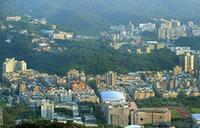Time-travel to Taiwan
 |
|
Three children pose with the train model at Tian Song Bei Station in Yilan. [Photo by Liu Hui / for China Daily] |
Every member of our delegation was impressed by this attitude of the people we met. One day we swooped into a fishing port in Keelung and jumped onto several boats. The fishermen were surprised, but as soon as they learned of our purpose they blithely cooperated and even struck some poses for us. "I have not met a single person who is nasty," said Zhang Feng, photographer with The Beijing Evening News.
|
 |
 |
Sure, the display of traditional virtues in such high profile could be window-dressing, but it is more than that. We met a middle-aged woman in Daxi, an old town by the Tamsui River where a century ago cargo ship would dock and turn the place into a hub of trading. Now it's a quiet town with a couple of commercial streets. On one of them, which is quite touristy, we talked to this woman who gave up her job to take care of her father.
The old man has to get around in a wheelchair and his medical expenses have been covered by welfare, but the full-time care by a family member would be something of a luxury to most families in the Chinese mainland. "We get some income from renting out a storefront," she explains, without a hint of bitterness or regret.
In the ensuing days, we encountered other examples of this nature, where a grownup child gives up his or her job to care for an ailing parent. I don't know how popular the practice is in Taiwan, but it's the ultimate manifestation of "filial piety", a concept sanctified in Chinese tradition.
"We just scratched the surface," said Wang Wenyang, photographer with a newspaper devoted to intellectual property protection in China. "We didn't have time to go into people's homes for long stretches of time. But from what we could see, the daily lives of Taiwan people have shown sufficiently the lifestyles and human interaction that are the bedrock of this society. It is heavy on small business and it is full of human warmth. We did bump into two weddings, though."
On Dihua Street in downtown Taipei, I strolled into a store that has a plaque saying this is the oldest store in the city. Now it sells tea from all over China. The architecture along the street probably goes back to the early days of the Republic of China. But at that time, Taiwan was still occupied by the Japanese.
Whether in architecture or food or ways of life, Taiwan seems to have absorbed from all sources, taking what is good and valuable and making it its own. In Ho-Ping Island Hi Park in Keelung, there is a seashore with rocks carved by millions of years of winds and water, similar to the nearby Yeliu Geopark. Despite a gust, a couple of fisherwomen were scouting for a certain seaweed that goes into a local snack. A few of our photographers jumped down to search for the best shots.
Meanwhile, our guide told us this was the location Chiang Kai-shek landed after he retreated from the mainland in 1949. Across the strait lies Fujian province, where most of the early settlers in Taiwan hailed from. For many decades, there was something stronger than the gusty wind to prevent people from calling on each other. Now it's just a short flight away.
After a week of going around Taipei, we stuffed our bags with Taiwan pastry and the memory of a way of life that used to live in ancient textbooks and is now so hauntingly real. It's not the most touristy place, but in an unconscious way it offers a corridor into our past.














